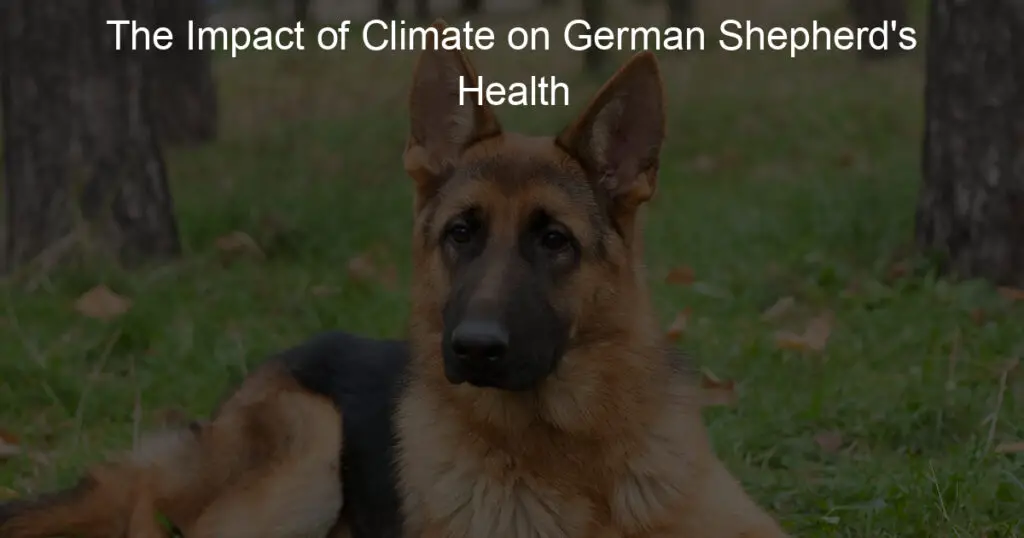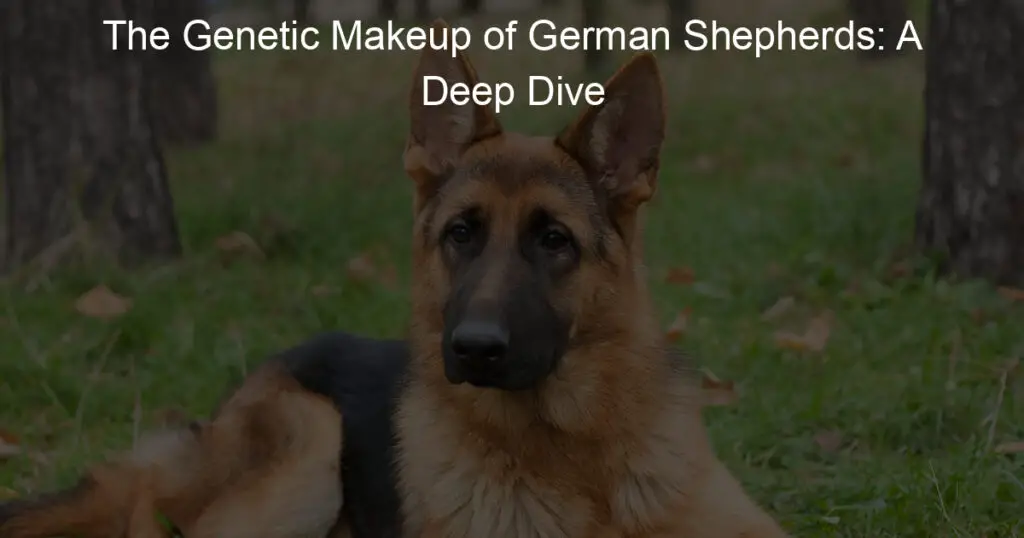In this blog post, we delve into an often-overlooked topic – the impact of climate on the health of German Shepherds. As the Earth's climate changes, it is crucial to understand how these shifts can affect our beloved pets, particularly breeds like the German Shepherd that are known for their adaptability. We explore the various health risks and benefits associated with different climates, discuss ways to mitigate potential issues, and highlight the importance of understanding your German Shepherd's individual needs.
Understanding German Shepherds: A Breed Overview
German Shepherds are a popular and beloved breed known for their intelligence, loyalty, and versatility. Originally developed in Germany in the late 19th century, they were primarily bred for herding and guarding livestock. Today, German Shepherds are widely recognized for their work in various fields, including search and rescue, police and military service, and as family companions.
One of the distinguishing features of German Shepherds is their strong and muscular build. They have a medium to large size, with males typically weighing between 65-90 pounds and females between 50-70 pounds. Their double coat consists of a dense outer layer and a softer undercoat, providing insulation and protection from the elements. German Shepherds come in a variety of colors, including black, sable, and black and tan.
In terms of temperament, German Shepherds are known for their obedience, courage, and protective nature. They are highly trainable and eager to please, making them excellent working dogs. However, they also require mental and physical stimulation to prevent boredom and maintain their overall well-being. German Shepherds are known to be loyal and affectionate towards their families, but their protective instincts can make them wary of strangers.
How Does Climate Affect Dogs Generally?
Climate plays a significant role in the overall health and well-being of dogs, including German Shepherds. Just like humans, dogs are susceptible to the effects of extreme temperatures. Hot climates can lead to heat exhaustion, heatstroke, and dehydration, while cold climates can cause hypothermia and frostbite. Dogs have different mechanisms to regulate their body temperature, such as panting and sweating through their paw pads, but extreme temperatures can overwhelm these mechanisms.
In hot climates, dogs are at risk of overheating, especially those with thick coats like German Shepherds. They may struggle to dissipate heat efficiently, leading to heat-related illnesses. It is important to provide ample shade, access to fresh water, and avoid exercising them during the hottest parts of the day. Additionally, breeds with shorter muzzles, like Bulldogs, are more prone to heat-related issues due to their compromised ability to cool down through panting.
On the other hand, cold climates can pose different challenges for dogs. Breeds with short coats, like Greyhounds, may struggle to retain body heat and require extra insulation during colder months. German Shepherds, with their double coats, are generally more tolerant of colder weather, but they too can be susceptible to hypothermia and frostbite if exposed to extreme cold for prolonged periods. Providing adequate shelter, such as insulated dog houses, and utilizing protective gear like dog sweaters or boots can help mitigate these risks.
Climate can also impact dogs' respiratory systems, particularly in areas with high humidity or pollution levels. Dogs with pre-existing respiratory conditions or brachycephalic breeds, such as Pugs or Bulldogs, may experience exacerbated symptoms in such climates. Additionally, dogs with light-colored or thin coats may be more susceptible to sunburn in sunny climates.
"Too Cold, Too Hot, or Just Right?" – Deciphering Your German Shepherd's Comfort Zone
Determining your German Shepherd's comfort zone when it comes to temperature is crucial for their well-being. While German Shepherds are generally adaptable to different climates, each dog has its own preferences and tolerance levels. Observing your dog's behavior and physical cues can help you decipher whether they are too cold, too hot, or just right.
When it comes to cold weather, keep an eye out for signs of discomfort such as shivering, reluctance to go outside, or seeking warm spots in the house. Some German Shepherds may even exhibit changes in their posture or become less active when they are feeling cold. On the other hand, if your dog seems excessively panting, seeking shade, or lying on cool surfaces during hot weather, it may be an indication that they are feeling too hot.
Monitoring your German Shepherd's body language is another helpful indicator. If they are curled up and tucking their tail close to their body, they may be trying to conserve heat in colder temperatures. Conversely, if they are stretching out and panting with their tongue out, it could be a sign that they are trying to cool down in warmer weather.
It's important to note that individual factors such as age, overall health, and activity levels can also influence a German Shepherd's temperature preferences. Older dogs or those with certain health conditions may be more sensitive to extreme temperatures. Additionally, puppies and highly active dogs may have higher energy levels and be more tolerant of cooler weather.
The Impact of Cold Climates on German Shepherds
Cold climates can have a significant impact on German Shepherds' health and well-being. These dogs, known for their thick double coats, are generally well-suited to colder environments. However, extreme cold can still pose risks to their health.
The cold weather can affect a German Shepherd's joints and muscles, making them more susceptible to arthritis and stiffness. The drop in temperature can cause their muscles to tighten, leading to discomfort and decreased mobility. It's important to provide warm and comfortable bedding for your German Shepherd to alleviate any potential joint issues.
Another concern in cold climates is hypothermia. German Shepherds, like all dogs, are vulnerable to this condition when exposed to prolonged periods of low temperatures. Signs of hypothermia include shivering, lethargy, pale gums, and a drop in body temperature. If you suspect your German Shepherd is experiencing hypothermia, it is essential to seek immediate veterinary attention.
Additionally, cold weather can lead to dry and cracked paw pads. Ice, snow, and salt used to melt ice on roads can be abrasive and cause irritation. It's important to regularly inspect your German Shepherd's paws for any signs of damage and provide protective measures such as booties or paw balms to keep their paws moisturized and shielded from harsh elements.
The cold climate can also impact a German Shepherd's respiratory system. Cold air can cause their airways to constrict, making breathing more difficult. This can be especially problematic for German Shepherds with pre-existing respiratory conditions. If you notice any abnormal breathing patterns or signs of distress, consult with your veterinarian for appropriate management strategies.
Summers and German Shepherds: A Hot Topic
As the temperatures rise during the summer months, German Shepherds face unique challenges in staying cool and comfortable. Their thick double coats, while beneficial in colder climates, can be a hindrance in hot weather. German Shepherds are more prone to overheating due to their dense fur, which traps heat close to their bodies. It's crucial to be aware of the signs of heat exhaustion or heatstroke in your German Shepherd. Excessive panting, drooling, lethargy, and difficulty breathing are all indicators of heat-related distress.
To help your German Shepherd beat the heat, provide them with plenty of fresh, cool water to stay hydrated. Consider setting up a shaded area in your yard or providing access to a cool room indoors. Avoid taking your German Shepherd for walks during the hottest parts of the day and opt for early morning or late evening outings when temperatures are lower.
Grooming also plays a crucial role in keeping your German Shepherd comfortable during the summer. Regular brushing helps remove loose fur and prevents matting, allowing better airflow to the skin. However, avoid shaving your German Shepherd's coat completely, as their fur provides insulation and protection against sunburn.
Another concern during hot weather is the risk of paw pad burns from hot pavement or sand. Before taking your German Shepherd for a walk, test the ground temperature by placing your hand on it for a few seconds. If it feels too hot for your hand, it's too hot for your dog's paws. Consider using booties or walking your German Shepherd on grass or shaded paths to prevent burns.
The Ideal Climate for a German Shepherd: Is There Such a Thing?
German Shepherds are a versatile breed that can adapt to various climates. However, certain climate conditions are more suitable for their overall well-being. While there may not be a single ideal climate for all German Shepherds, there are factors to consider when determining the most favorable environment for them.
First and foremost, it's important to note that German Shepherds are not well-suited for extreme temperatures, whether hot or cold. They are more comfortable in moderate climates where the temperatures are not too extreme. This means that regions with mild summers and winters are generally preferable for German Shepherds.
The coat of a German Shepherd plays a significant role in their ability to regulate body temperature. In colder climates, their thick, double coat provides insulation and protection against the cold. However, in warmer climates, this dense fur can be a burden, making them susceptible to heat-related issues. Therefore, regions with milder summers help prevent overheating and keep German Shepherds comfortable.
Humidity is another factor to consider. High levels of humidity can make it more difficult for German Shepherds to cool down, as it hampers the evaporation of moisture from their bodies. Regions with moderate humidity levels are generally more suitable for German Shepherds.
Additionally, access to shade and proper ventilation is crucial for German Shepherds in any climate. They require a cool and well-ventilated space to retreat to when temperatures rise. Whether it's a shaded outdoor area or an air-conditioned room indoors, providing a comfortable environment is essential for their overall health.
Finally, it's worth noting that individual differences within the breed should also be taken into account when determining the ideal climate for a German Shepherd. Some German Shepherds may have a higher tolerance for heat or cold, while others may be more sensitive. It's important to observe your specific dog's behavior and consult with a veterinarian for guidance on the most suitable climate for their well-being.
Climate Change: What Does It Mean for German Shepherds?
Climate change is a pressing global issue that has far-reaching consequences for all living beings, including our beloved German Shepherds. The changing climate patterns and extreme weather events associated with climate change can have a significant impact on the health and well-being of these dogs.
One of the most noticeable effects of climate change is the increase in extreme temperatures. Rising temperatures can pose serious risks to German Shepherds, especially those with thick coats that make them more susceptible to heat-related illnesses. Heat exhaustion and heatstroke become more common as summers become hotter and longer. It is crucial for owners to take proactive measures to protect their German Shepherds from the heat, such as providing access to shade, keeping them hydrated, and avoiding strenuous activities during the hottest parts of the day.
Climate change can also lead to changes in environmental conditions that affect the spread of diseases and parasites. Warmer temperatures and altered precipitation patterns can create more favorable conditions for the proliferation of ticks, fleas, and mosquitoes, increasing the risk of vector-borne diseases. German Shepherds can be vulnerable to diseases such as Lyme disease and heartworm, which can have serious health implications. Regular preventive measures, such as tick and flea control, and heartworm prevention become even more crucial in a changing climate.
Furthermore, climate change can disrupt the availability of resources and impact the food chain, which can indirectly affect the health of German Shepherds. Changes in weather patterns can result in alterations in the availability and quality of food sources for the animals they prey on or consume. This can lead to nutritional imbalances and deficiencies, impacting the overall health of German Shepherds. It is essential for owners to be vigilant about their dog's diet and ensure they are receiving proper nutrition and supplements if necessary.
In conclusion, climate change poses numerous challenges for German Shepherd health and well-being. From increased heat risks to changes in disease patterns and resource availability, it is crucial for owners to stay informed, adapt their care strategies, and take proactive measures to protect their German Shepherds in an ever-changing climate.
Adapting to Change: How German Shepherds Cope with Climate Shifts
German Shepherds are remarkably adaptable animals and have evolved to cope with various climates over the years. They possess certain physiological and behavioral traits that help them adjust to changing environmental conditions. Firstly, their double coat serves as insulation, keeping them warm in colder climates and providing some protection against heat in hotter regions. As the climate shifts, German Shepherds have the ability to shed their undercoats to regulate body temperature. This shedding process ensures that they don't overheat in warmer climates. Additionally, their large, upright ears help to dissipate heat and regulate body temperature. These adaptations allow German Shepherds to tolerate a wide range of temperatures, from cold winters to hot summers.
In terms of behavior, German Shepherds are known for their intelligence and problem-solving abilities. They can learn to seek out shade or cooler areas during hot weather and find warmer spots during colder seasons. They may also adjust their activity levels accordingly, becoming more active during cooler parts of the day and seeking rest during the hottest hours. Furthermore, German Shepherds have a strong pack instinct and tend to bond closely with their human families. This bond can provide emotional support and a sense of security during times of environmental change, helping them to cope with the stress that may come with climate shifts.
While German Shepherds possess these natural adaptations, it is important for owners to provide additional support during extreme climate events. This can include providing access to climate-controlled indoor spaces during heatwaves or providing extra insulation during cold winters. Monitoring their behavior and health closely during times of climate shifts is crucial to ensure their well-being. By understanding and supporting their natural coping mechanisms, we can help our German Shepherds navigate the challenges that climate change presents.
Can Climate Impact a German Shepherd's Lifespan?
Climate can indeed have an impact on a German Shepherd's lifespan. Extreme weather conditions, whether excessively hot or cold, can put stress on their bodies and potentially lead to health issues. For instance, prolonged exposure to high temperatures can cause heatstroke, dehydration, and organ damage in German Shepherds. On the other hand, extremely cold temperatures can lead to frostbite, hypothermia, and joint stiffness. These conditions can be particularly harmful to older or more vulnerable dogs, potentially shortening their lifespan.
Moreover, climate change and its associated effects, such as rising temperatures and unpredictable weather patterns, can further contribute to health risks for German Shepherds. Increased heatwaves and extreme weather events can place additional strain on their bodies and make it more challenging for them to regulate their temperature. The resulting stress can impact their overall health and potentially reduce their lifespan. Additionally, climate change can also lead to changes in the distribution of pests and diseases, exposing German Shepherds to new health threats. For example, the spread of tick-borne diseases may become more prevalent in certain areas, posing a risk to the health and longevity of German Shepherds.
To mitigate the impact of climate on a German Shepherd's lifespan, it is essential for owners to take proactive measures. This includes providing proper shelter and access to climate-controlled environments during extreme weather conditions. Regular veterinary check-ups and preventive measures such as vaccinations and tick control can also help protect them from climate-related health risks. Additionally, owners can adapt their exercise routines and adjust the intensity and duration of outdoor activities based on the weather conditions. By being aware of the potential effects of climate on their German Shepherd's health and taking appropriate precautions, owners can help ensure their beloved companions live longer, healthier lives.
Mitigating Climate-Related Health Risks for German Shepherds
When it comes to mitigating climate-related health risks for German Shepherds, there are several important measures that owners can take. Firstly, providing ample access to fresh water is crucial, especially during hot weather. Dehydration can occur rapidly in dogs, so ensuring a constant supply of clean water can help prevent heat-related illnesses. Additionally, setting up shaded areas in the yard or using a dog-friendly sunshade can provide relief from the scorching sun.
Another key aspect is regulating exercise during extreme weather conditions. While German Shepherds are an active breed that requires regular physical activity, it is important to be mindful of the temperature. During hot weather, it's best to exercise them during the cooler parts of the day, such as early morning or late evening. This can reduce the risk of heat exhaustion or heat stroke. On the other hand, in cold climates, it's important to keep exercise sessions shorter and provide warm coats or sweaters to protect them from the cold.
Proper grooming is also essential in mitigating climate-related health risks. Regular brushing helps to remove excess fur, allowing for better airflow and ensuring that their coat can effectively regulate their body temperature. In hot climates, it may be beneficial to trim their fur, but in colder climates, keeping their coat longer can provide insulation against the cold.
Additionally, paying attention to their paws is crucial. Hot pavement or sand can burn their paw pads, while cold surfaces can cause discomfort or even frostbite. Checking and cleaning their paws after walks and avoiding walking them on extreme surfaces can help prevent such issues.
Diet and Exercise: Do They Vary with Climate?
When it comes to diet and exercise for German Shepherds, it is important to consider the impact of climate on their nutritional needs and activity levels. The climate in which a German Shepherd lives can influence their metabolism, energy expenditure, and overall health. Here are three key factors to consider:
- 1. Nutritional Requirements:
In hot climates, German Shepherds may have increased water needs to stay hydrated. Additionally, high temperatures can affect their appetite, leading to reduced food intake. It's important to provide a balanced and nutritious diet that meets their specific needs, especially in terms of protein, which is essential for muscle maintenance and repair. Consult with a veterinarian to ensure your German Shepherd's diet is appropriate for the climate they live in. - 2. Exercise Intensity:
In hot climates, it is crucial to adjust the intensity and duration of exercise sessions to prevent overheating. Avoid exercising them during the hottest parts of the day and opt for shorter, more frequent walks or play sessions during cooler periods. On the other hand, in colder climates, German Shepherds may require additional exercise to stay physically and mentally stimulated. Consider engaging in indoor activities or providing them with appropriate outdoor gear to protect them from the cold. - 3. Environmental Enrichment:
Both diet and exercise can be influenced by the climate, but it's also important to provide environmental enrichment for German Shepherds in different weather conditions. In hot climates, provide access to cool, shaded areas, and consider interactive toys or puzzles that can keep them mentally stimulated indoors. In colder climates, ensure they have comfortable and warm bedding, and engage in activities that provide mental stimulation, such as obedience training or interactive feeding toys.
"One Size Fits All?" – Recognizing Individual Differences in Climate Tolerance
Just like humans, German Shepherds have individual variations in their tolerance to different climates. While some may thrive in colder environments, others may struggle to adapt. It's important to recognize and respect these individual differences when it comes to climate tolerance. Here are a few factors to consider:
- 1. Coat Type:
German Shepherds have a double coat, consisting of a dense undercoat and a longer, coarser outer coat. This coat provides insulation and protection from the elements. However, the thickness and length of the coat can vary among individuals. Dogs with a thicker and longer coat may be better suited to colder climates, while those with a thinner coat may struggle in extreme cold or hot conditions. - 2. Age and Health:
Young puppies and older German Shepherds may have a harder time regulating their body temperature, making them more susceptible to extreme weather conditions. Additionally, dogs with certain health conditions, such as respiratory issues or arthritis, may have reduced tolerance to temperature extremes. It's important to monitor their comfort level and make adjustments accordingly. - 3. Previous Exposure and Acclimation:
German Shepherds that have been raised or spent a significant amount of time in a specific climate may be more acclimated to it. Dogs that have been consistently exposed to cold or hot climates may have developed adaptations to better cope with those conditions. However, sudden changes in climate or relocation to a different region may require a period of adjustment.
Consulting a Professional: When and Why It's Necessary
Consulting a professional, such as a veterinarian or a breed specialist, can be crucial when it comes to understanding and managing the impact of climate on your German Shepherd's health. Here are a few situations when seeking professional advice is necessary:
- 1. Extreme Climate Conditions:
If you live in an area with extreme climates, such as exceptionally cold winters or scorching hot summers, it is important to consult with a professional to ensure your German Shepherd's well-being. They can provide guidance on protective measures, such as appropriate clothing or shelter options, to keep your dog safe and comfortable. - 2. Relocating to a New Climate:
If you are planning to move to a different climate, especially one with significant temperature differences, consulting a professional is essential. They can help you understand how your German Shepherd may adapt to the new environment and provide recommendations on how to ease the transition. - 3. Health Concerns:
If your German Shepherd has pre-existing health conditions or exhibits signs of discomfort or distress related to the climate, it is crucial to consult with a professional. They can assess your dog's overall health and provide specific recommendations or treatments to address any climate-related health issues. - 4. Breed-Specific Considerations:
German Shepherds have their own unique characteristics and vulnerabilities when it comes to climate. A breed specialist can provide valuable insights into how climate may affect your German Shepherd's health and offer recommendations tailored to their specific needs.
Impact of Climate on German Shepherd's Health:
| Climate | Health Benefits | Health Risks | Mitigation |
|---|---|---|---|
| Hot | Heat tolerance | Heat Stress | Provide shade and cool water |
| Cold | Thicker coat | Frostbite | Keep indoors during extreme temperatures |
| Humid | None | Heat stroke, skin infections | Proper grooming and ventilation |
| Dry | Heat tolerance | Dehydration, skin irritation | Provide plenty of water |
Understanding the impact of climate on your German Shepherd's health is crucial for their well-being. As our world's climate continues to change, being aware of potential health issues and knowing how to prevent or treat them can make a significant difference in your German Shepherd's life. Above all, it's important to remember that every dog is unique, and what works for one might not work for another. Always consult with a professional before making any significant changes to your pet's routine or environment.















